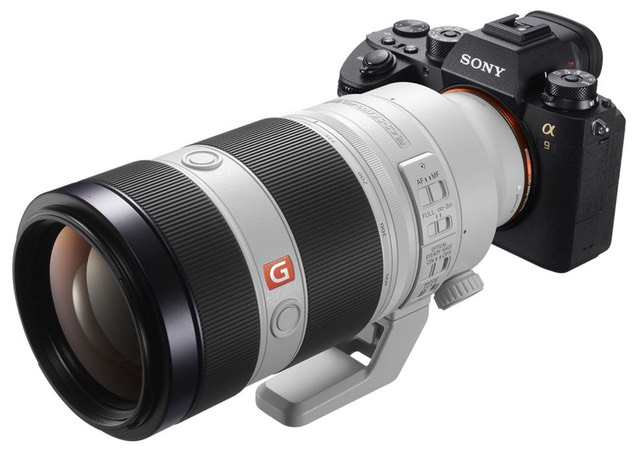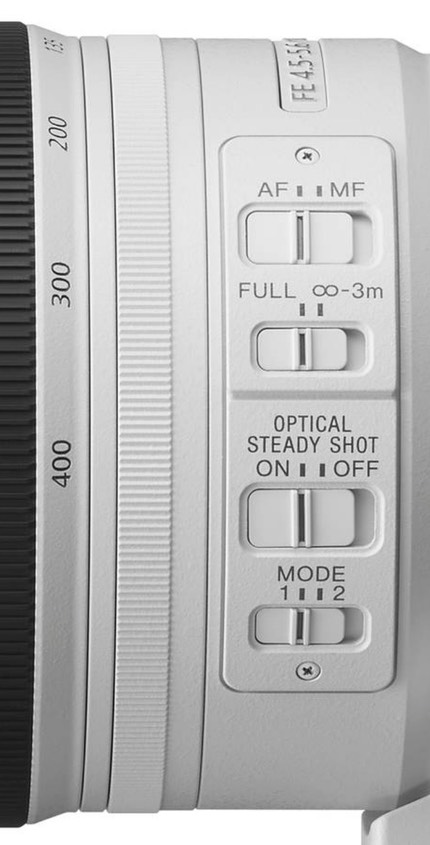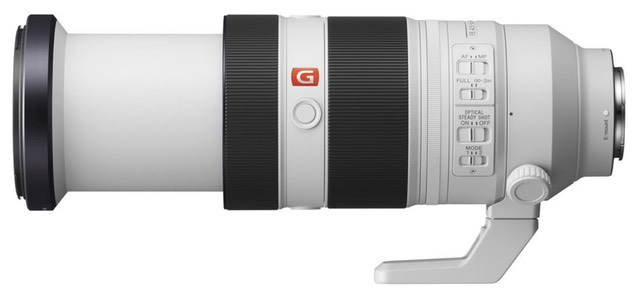
What is It?
The 100-400mm f/4.5-5.6 GM OSS lens is Sony's first high quality telephoto lens that gets you past 200mm on the FE mount. This is a lens that covers a broad telephoto range over the full frame, which is useful for wildlife and sports shooters.
The GM designation means that Sony has attempted to make for both high sharpness coupled with a design that renders out-of-focus backgrounds well (bokeh). That's trickier than it sounds, as those design goals often come in conflict with one another. We'll get to how the lens fares at that in the performance section later.
Meanwhile, the GM lenses also have a high feature level and build quality. So let's deal with the lens particulars first.
Like a lot of telephoto zooms with high specifications, the 100-400mm has an extensive optical formula: 22 elements in 16 groups, with two ED elements and one super ED element. ED elements are low dispersion glass that attempts to keep spectral information from focusing at different planes, and are one of the primary optical tactics in controlling chromatic aberration.
Despite all that glass, the design and the Nano AR multicoating manages to keep the light transmission reasonably high and without ghosting for an f/5.6 lens with this much glass. It's probably t/7. A circular 9-blade aperture diaphragm is inside, but as I find with many lenses, it is not perfectly symmetrical. My sample is more of what I'd call a slightly kinky elliptical.
Sony's theoretical MTF charts for this lens show remarkably good intended performance, with tangential values showing not a lot of drop-off. That's usually a sign of good aspherical correction out into the corners. Again, we'll see how that stacks up later in the review.
Up front we have filter threads of 77mm. One really nice touch is Sony's included ALC-SH151 lens hood, which has a retractible door on it so that you can adjust circular polarizers without having to reach down a huge plastic tunnel.
The autofocus system in the lens is Sony's double linear motor design, where two direct drive motors control different lens element groups during the focus operation rather than one motor driving a single and often larger mass.
Close focus distance is a couple of millimeters shy of 1m, resulting in a remarkably good close focus distance of 3.22 feet. That also provides a maximum magnification ratio 1.2.9, which isn't quite macro land, but not far from it. Focus can be limited to 3m to infinity via switch (see below).
Build quality is high, as it is for all GM lenses, and like Sony's other telephoto designs, much of the barrel is white. That's likely to keep heat from disrupting ED glass performance (most low dispersion glass shifts its focal plane slightly with temperature, which isn't a problem for autofocus designs, but does sometimes keep a lens from achieving true infinity focus).
The fly-by-wire focus ring is near the very front of the lens, the zoom ring a bit further back. In between the rings are three programmable function buttons (by default set to focus hold; see my comments in the handling section). The two rings are not really differentiated by feel of the rubber, though you'll notice an immediate difference in resistance if you try to turn them. Not the best way to distinguish by feel, but acceptable.
The zoom ring rotates through five marked focal lengths in about a quarter turn. Markings are at 100, 135, 200, 300, and 400mm, all common focal lengths. Unique to the zoom ring is a "smoothness adjustment" that adjusts the turn resistance. Leaving the lens on "smooth" will result in zoom creep when the lens is pointed up or down. I pretty much left mine set to "tight" and experienced no creep, despite a lot of sideline handling.

Four switches are arrayed on one side of the lens: focus mode, focus-range limiter, Optical Steady Shot (OSS) on/off, and OSS mode. As usual with the Japanese products, we get VR modes labeled with 1 and 2 as if they mean something to users (mode 1 is "normal" and mode 2 is "panning", now how would that have been to put on the lens? Don't tell me that English isn't used for labeling on the lens: the other switches are labeled with English words).
A rotating tripod collar features a removable foot, a design that will make third party feet easier to make, but which I think leaves a bit of play in the overall support. The collar itself is near the lens mount of a larger and heavier lens, which puts a lot of mass out front of it, so any looseness is transmitted with vibration. Like most of my Nikkors that feature this design, the 100-400mm fails my tap test. I can get it to usable by over tightening the lock knobs, but that, too can have long term implications.
Without the tripod foot, the lens weighs in at a hefty 3 pounds, 1.3 ounces (1395g).
The lens comes with a nice carrying case, and is dust and moisture resistant. Price is US$2500. The lens is made in Japan.
Source of review lens: one month loan from B&H
How's it Handle?
Look, I like function buttons on the lens. They can be quite useful. Or not. Set at defaults I kept trying to figure out why the camera would stop focusing every now and then. Turns out that my support hand under the lens kept hitting the bottom function button. I'm not even sure why there's a button on the bottom with a lens like this. The left hand button falls naturally under the left thumb when you're hand-holding this lens, but the bottom button is right about where your hand is likely to be, at least part of your hand. On a monopod, that bottom button can be very close mount/pod.
I already mentioned the zoom creep if you elect "smooth" for the zoom ring. The good news is that the inner tube that slides out as you zoom in doesn't have the usual waggle problem you find on consumer zooms. There's no sloppiness that allows that front set of elements to move slightly out of centered position, a common problem with the cheaper variable aperture zooms.

Overall the lens handles well for a biggish one. I use the term biggish because I can't actually call the lens big. It is a bit bigger than my Nikkor 80-400mm f/4-5.6, but it's also not one of those lenses that, when you look on the sidelines, it looks like the photographer is struggling to keep up.
Indeed, I shot quite a bit with this lens completely handheld. During day football games, I had a high enough shutter speed that I didn't need my monopod. At night, however, I needed it. Either way, the lens fits naturally in the hand, isn't too heavy for extended use, and other than that frustrating button position and default, never gave me an issue.
How's it Perform?
Note: due to the short review period I had on this lens I wasn't able to run all my tests on it.
Focus: I was surprised not to find any issues here. A lot of times with the variable aperture telephoto zooms you find some focus speed issues, but not here. The two-motor approach Sony is using obviously works, and works well enough for birds in flight and for fast-moving sports (assuming the camera body is up to it ;~).
Focusing tends to be quick and silent. At extreme close-to-far or far-to-close changes, you may see a bit of "slide-to-focus", particularly at 400mm, but even my exotic Nikons can produce that effect on the big DSLRs when you push them from infinity to close focus distance.
I did notice some minor hunting in low light at the extremes (e.g. 400mm and close focus), but not enough to worry about. Overall I'd judge the focus performance to be excellent.
Sharpness: Here's where my lack of full lab testing time comes into play. I'm having to assess this lens visually from sample images more so than my usual test charts and static scenes, so I may be a bit more vague than usual. I shot a lot of images like this in assessing performance, both flat onto the subject as well as offset as is the case here (sometimes you see something different in flat field captures):

That image is 400mm f/5.6, and I was surprised at how well the sharpness held up edge to edge, one reason why I'm showing it. But note the slight pin cushion distortion (most noticeable on left corner of building).
Central area is excellent at all focal lengths, I'd say. It's the corners where some differences start to come into play. At 100mm, the corners are quite decent, and I'd bet I'd call them very good if I had the full set of test chart results I normally do at a range of distances. 400mm is different story, especially at the closer focus distances. There, the corners have clear loss of acuity, though it's not a smeary loss, it's just more likely something like field curvature loss coupled with some very modest astigmatism. I'd be tempted to call the lens good at 400mm in the corners, but it might be very good. For the things I'd use a 400mm lens for, I find the level of sharpness to be fine, even wide open: the center is excellent, I've got fall off of that sharpness as I approach the corners, but no smearing. Generally I have centered or near centered subjects at 400mm and the edges aren't where I want the user's eyes to go. I'm fine with what the Sony produces here.
Overall, through most of the lens' range you'd want to stop down one stop for truly optimal results (particularly the corners), but at 100mm it might not be worth it.
Indeed, I'd gauge this Sony lens as better than the Nikkor 80-400mm at 400mm, and in all respects. That's a very good bar to get above.

This is one image from a sequence of 50 (!). The lens had no trouble keeping focus where the camera asked during the entire sequence. Generally focus snapped into place quickly and rarely hunted. While I would have liked a faster aperture, you do get a little benefit from DOF, which can be useful in frames like this. Generally f/5.6 telephoto lenses tend to be a little less secure at holding focus on fast or erratic motion, but again, that's not at all an issue on the 100-400mm.
Linear Distortion: I was not able to do my usual testing here, but I'm not seeing any significant distortions I immediately want to correct other than at 400mm, where pin cushion distortion is clearly visible and may be as high as 2-3%. Of course, the camera can offer to fix those for you if you're shooting JPEG.
Vignetting: Surprisingly more vignetting at 100mm than 400mm wide open. But both have very wide central areas that are mostly unaffected. It's really the extreme corners where I see vignetting, and not as bad as I'd expect. Probably a bit more than a stop at 100mm f/4.5.
Chromatic Aberration: Another surprise was that there's definitely longitudinal chromatic aberration present wide open. Normally you don't see that with variable aperture zooms that are slightly on the slow side like this, but it's definitely there: magenta fringing forward, green to the background. It's more true of 100mm f/4.5, but it's present still at 400mm f/5.6. And gone by f/8.
Lateral chromatic aberration is actually much better controlled, though still present in very small quantities.
Bokeh: I'm not sure you can really talk about bokeh in a slower lens like this, though certainly if you are shooting closer subjects with distant backgrounds (e.g. some sports) it might come into play. The actual blur circles are a bit busy, with coloration on the outer edges of small background highlights. But in general, the background blurs are what I'd call good. I wasn't finding the really bad mid-background busyness I do with some telephoto zooms (e.g. the old Nikkor 70-300mm, which has a reputation for this, particularly with VR turned on).
Final Words
Yes, the Sony 100-400mm f/4.5-5.6 GM OSS is an expensive lens at US$2500, but it's also the lens that the A9 users are likely to be using for awhile to get reach for wildlife and sports. They'll be quite pleased with it, I think. Aside from a couple of minor handling issues including the slightly suspect tripod collar, there's nothing to fault here. The optics are excellent for the focal lengths, even considering the price point. The build quality is excellent, and there are a few nice extra touches on this lens, too.
Overall, if you need something beyond 200mm on your A7/A9 body, this is the lens you should be considering. A really nice effort from Sony, and worthy of the GM designation.
Recommended (2017 to present)
Support this site by purchasing from the following advertiser:
